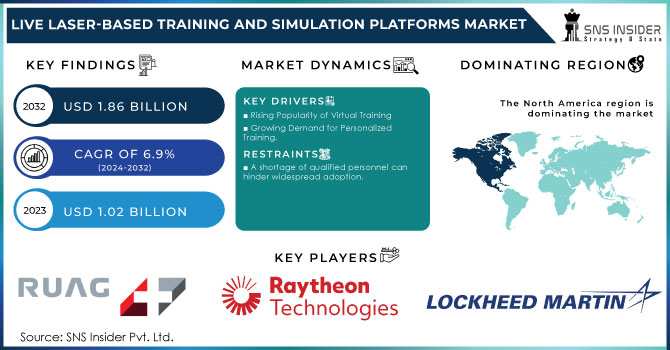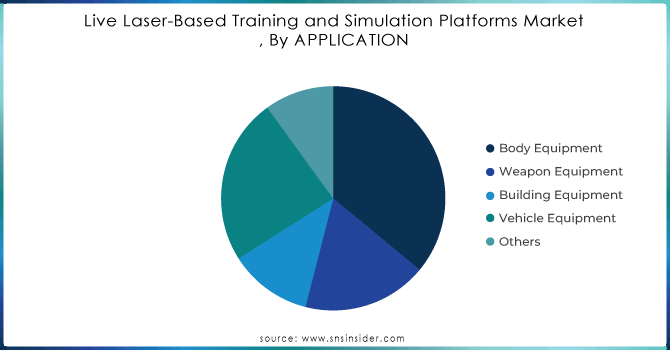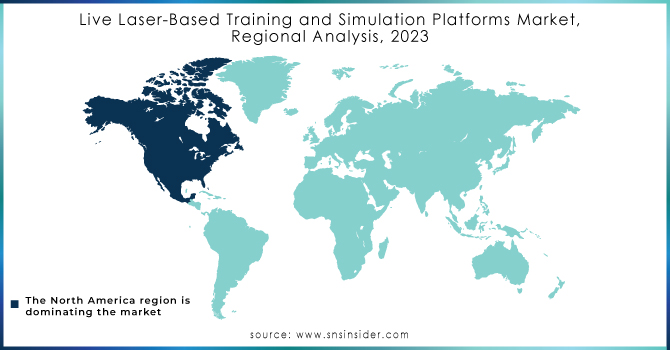Live Laser-Based Training and Simulation Platforms Market Report Scope & Overview:

To get more information on Live Laser-Based Training and Simulation Platforms Market - Request Free Sample Report
The Live Laser-Based Training and Simulation Platforms Market Size was valued at USD 1.02 Billion in 2023 and is expected to reach USD 1.86 Billion by 2032 and grow at a CAGR of 6.9% over the forecast period 2024-2032.
Live laser-based training and simulation platforms utilize lasers and simulations to create realistic training environments for various sectors, including defense, civil aviation, education, and even entertainment. This expansion can be attributed to the rising popularity of virtual training methods, driven by growing awareness of their effectiveness and safety, and the increasing demand for personalized training solutions across diverse industries like healthcare and defense. However, the market faces challenges in the form of technical complexities and a lack of interoperability between different systems. Nevertheless, advancements in artificial intelligence are demonstrably enhancing the realism and effectiveness of simulations, while the integration of live human instructors further strengthens the training experience.
MARKET DYNAMICS
KEY DRIVERS:
-
Rising Popularity of Virtual Training
Increased awareness of the effectiveness and safety of virtual training methods compared to traditional approaches is fueling market growth.
-
Growing Demand for Personalized Training.
RESTRAIN:
-
A shortage of qualified personnel can hinder widespread adoption.
OPPORTUNITY:
-
Development of Modular and Scalable Systems
Designing platforms with modular components and scalable capabilities would allow for easier customization and adaptation to different training environments and budgets.
-
Integration of Artificial Intelligence (AI)
CHALLENGES:
-
Creating realistic training environments may require dedicated physical spaces, which can be a constraint for some users.
IMPACT OF RUSSIA UKRAINE WAR
The Russia-Ukraine war presents a complex scenario for the live laser training market. While increased global defense spending, projected to reach $2.1 trillion in 2022, could fuel demand for military training platforms and accelerate pre-existing market growth (estimated at USD 1.8 billion by 2031). Disruptions in supply chains due to the war could delay production and delivery. Additionally, increased military spending might divert resources from other sectors that utilize these platforms, like civil aviation. Finally, the overall economic uncertainty could lead to budget cuts and a cautious approach to investments, potentially impacting market growth across all sectors.
IMPACT OF ECONOMIC SLOWDOWN
Budgetary constraints, especially in sectors like civil aviation and education, could lead to decreased investments in these non-essential training tools. Additionally, companies might delay purchases due to economic uncertainty. Investor caution in the training technology sector could further dampen growth. However, there are potential silver linings. The focus on cost-effectiveness during downturns could make live laser training attractive due to reduced ammo, travel, and venue rental costs. Additionally, companies might prioritize upskilling their workforce, leading to a rise in training needs that could benefit the market in the long run. The overall impact depends on the severity and duration of the slowdown, but the market's potential for cost-effectiveness offers some hope for weathering the storm.
KEY MARKET SEGMENTS
BY APPLICATION
-
Body Equipment
-
Weapon Equipment
-
Building Equipment
-
Vehicle Equipment
-
Others
The Vehicle Equipment Segment is dominant within the live laser-based training and simulation platforms market, having secured a dominant position with market share of 43% in 2023. The dominance of vehicle equipment can be attributed to its critical role in facilitating realistic training scenarios.
Vehicle equipment functions by attaching to mechanized and armored vehicles, thereby enabling comprehensive communication across a vast training area. This ensures seamless connectivity between soldier and vehicle participants, fostering full situational awareness of the broader training exercise for each unit. Furthermore, the integration of laser detectors, laser transmitters, and status indicators within the vehicle equipment allows for the assessment of simulated threats and the analysis of ballistics data. This comprehensive data collection contributes to a highly realistic training experience, mirroring real-world situations as closely as possible.

Need any customization research on Live Laser-Based Training and Simulation Platforms Market - Enquiry Now
REGIONAL ANALYSIS
North America dominated the global market for live laser-based training and simulation systems. Future Integrated Training Environment, developed by the Canadian Army Doctrine and Training Centre, is a working idea for how the Army aims to harness existing and upcoming modelling and simulation technology to establish a framework for live, virtual, and constructive training. The FITE team has been circulating the concept and receiving comments for the establishment of standards through a multinational working group called as Modelling, Instrumentation, and Simulation for Training Systems under the ABCANZ framework.
Due to the increasing number of combat soldiers, military vehicles, and joint training exercises by military personnel, Asia-Pacific is predicted to grow at a promising rate during the projection period. The Asia-Pacific region is divided into China, India, Japan, South Korea, and the rest of Asia. It ranks third in the market for live laser-based training and simulation platforms. Military departments in Asia-Pacific countries are aiming to secure long-term training contracts with corporations. For example, the Australian Minister for Defense Industry granted a contract to In Veris Training Solutions (Georgia, US) to produce 14 simulators. It will supply and maintain a fully automated Mobile Weapons Training Simulation System.

REGIONAL COVERAGE
North America
-
US
-
Canada
-
Mexico
Europe
-
Eastern Europe
-
Poland
-
Romania
-
Hungary
-
Turkey
-
Rest of Eastern Europe
-
-
Western Europe
-
Germany
-
France
-
UK
-
Italy
-
Spain
-
Netherlands
-
Switzerland
-
Austria
-
Rest of Western Europe
-
Asia Pacific
-
China
-
India
-
Japan
-
South Korea
-
Vietnam
-
Singapore
-
Australia
-
Rest of Asia Pacific
Middle East & Africa
-
Middle East
-
UAE
-
Egypt
-
Saudi Arabia
-
Qatar
-
Rest of Middle East
-
-
Africa
-
Nigeria
-
South Africa
-
Rest of Africa
-
Latin America
-
Brazil
-
Argentina
-
Colombia
-
Rest of Latin America
Key players
Some of the major players in the Live Laser-Based Training And Simulation Platforms Market are RUAG Group, Raytheon Technologies Corporation, Inter-Coastal Electronics Inc., Cubic, Lockheed Martin Corporation, Saab AB, ZelTech, Rheinmetall AG, Thales Group, and other players.
RECENT TRENDS
-
In April 2023, Saab will provide support for the UK MoD’s live simulation systems though ILT-D under a three-year deal valued at £60 million (US$76 million). The deal will feature an option to extend the contract until 2030.
-
RUAG Simulation & Training (RUAG S&T) proved they can remotely monitor and support Live training systems for a European customer. This included analyzing what happened after the training (AAR reports), and the customer was very happy with the service.
| Report Attributes | Details |
|---|---|
| Market Size in 2023 | US$ 1.02 Billion |
| Market Size by 2032 | US$ 1.86 Billion |
| CAGR | CAGR of 6.9% From 2024 to 2032 |
| Base Year | 2023 |
| Forecast Period | 2024-2032 |
| Historical Data | 2020-2022 |
| Report Scope & Coverage | Market Size, Segments Analysis, Competitive Landscape, Regional Analysis, DROC & SWOT Analysis, Forecast Outlook |
| Key Segments | • By Application (Body Equipment, Weapon Equipment, Building Equipment, Vehicle Equipment, and Others) |
| Regional Analysis/Coverage | North America (US, Canada, Mexico), Europe (Eastern Europe [Poland, Romania, Hungary, Turkey, Rest of Eastern Europe] Western Europe] Germany, France, UK, Italy, Spain, Netherlands, Switzerland, Austria, Rest of Western Europe]), Asia Pacific (China, India, Japan, South Korea, Vietnam, Singapore, Australia, Rest of Asia Pacific), Middle East & Africa (Middle East [UAE, Egypt, Saudi Arabia, Qatar, Rest of Middle East], Africa [Nigeria, South Africa, Rest of Africa], Latin America (Brazil, Argentina, Colombia Rest of Latin America) |
| Company Profiles | RUAG Group, Raytheon Technologies Corporation, Inter-Coastal Electronics Inc., Cubic, Lockheed Martin Corporation, Saab AB, ZelTech, Rheinmetall AG, Saab, Thales Group, and other players. |
| DRIVERS |
• Rising Popularity of Virtual Training |
| RESTRAINTS |
• A shortage of qualified personnel can hinder widespread adoption. |

